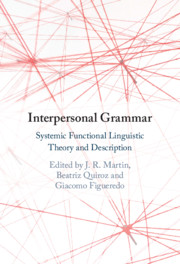Book contents
- Interpersonal Grammar
- Interpersonal Grammar
- Copyright page
- Contents
- Figures
- Tables
- Contributors
- 1 Introduction: Theory and Description in Interpersonal Grammar across Languages
- 2 Interpersonal Grammar in Spanish
- 3 Interpersonal Grammar in Khorchin Mongolian
- 4 Interpersonal Grammar in Mandarin
- 5 Interpersonal Grammar in Tagalog: Assessment Systems
- 6 Interpersonal Grammar of Pitjantjatjara
- 7 Interpersonal Grammar in Brazilian Portuguese
- 8 Interpersonal Grammar in British Sign Language
- 9 Interpersonal Grammar in Scottish Gaelic
- Index
- References
2 - Interpersonal Grammar in Spanish
Published online by Cambridge University Press: 21 May 2021
- Interpersonal Grammar
- Interpersonal Grammar
- Copyright page
- Contents
- Figures
- Tables
- Contributors
- 1 Introduction: Theory and Description in Interpersonal Grammar across Languages
- 2 Interpersonal Grammar in Spanish
- 3 Interpersonal Grammar in Khorchin Mongolian
- 4 Interpersonal Grammar in Mandarin
- 5 Interpersonal Grammar in Tagalog: Assessment Systems
- 6 Interpersonal Grammar of Pitjantjatjara
- 7 Interpersonal Grammar in Brazilian Portuguese
- 8 Interpersonal Grammar in British Sign Language
- 9 Interpersonal Grammar in Scottish Gaelic
- Index
- References
Summary
This chapter develops a carefully reasoned analysis of Spanish resources enacting the negotiability of propositions and proposals. Following a review of the ways in which English and French structure the negotiability of moves in conversation, the chapter turns to Spanish – demonstrating that it is the Predicator function, realised by verbal group resources, that manages the negotiability of the clause (with respect to those resources ‘most at risk’ in the exchange). The chapter shows that functions such as Subject or Finite have no place in the interpersonal grammar of a Spanish clause and closes with an overview of basic negotiatory structures in Romance languages, from the perspective of functional language typology.
- Type
- Chapter
- Information
- Interpersonal GrammarSystemic Functional Linguistic Theory and Description, pp. 34 - 63Publisher: Cambridge University PressPrint publication year: 2021
References
- 4
- Cited by



